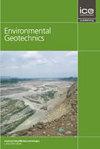水泥稳定黄土的微观结构与强度参数
IF 2.2
4区 工程技术
Q3 ENGINEERING, GEOLOGICAL
引用次数: 1
摘要
在本研究中,为了评价黄土土的硬度和稳定性,采用水泥作为稳定作用的组分。为了评价水泥加固黄土土的强度特性,制作了4种不同水泥浓度(3%、5%、7%和9%)和3种不同养护时间(7、14和28天)的样品。在一系列试验中,测定了试件的抗折强度、直剪强度、间接抗拉强度和无侧限抗压强度。找到了一个合适的水泥掺量,以及一个耐久性指标,该指标可用于量化水泥稳定黄土的吸水研究效果。这两项发现是同时进行的。通过扫描电子显微镜(SEM)和能量色散x射线荧光光谱(XRF)测试,可以了解材料的基本力学。结果表明:水泥稳定黄土的黏聚力对结构的敏感性远高于材料的摩擦角。重塑后抗剪强度的提高是由于粘聚作用。扫描电镜研究表明,水泥与黄土颗粒相互作用,形成较厚的水泥网,成功地覆盖了空隙,提高了混合物的强度参数。含7%水泥的试样的28天UCS最大,为3.5 MPa,而含9%水泥的试样的28天UCS为4.78 MPa。28d后测得最高抗弯强度为1.98 N/mm2。水泥掺量为3%、5%、7%、9%的试样抗拉强度在7 d后最大强度分别为0.15 MPa、0.23 MPa、0.27 MPa、0.37 MPa,且强度逐渐增大。为了达到理想的强度水平,需要调整水泥的比例。此外,随着养护期的延长,我们观察到由于结构和矿物成分之间的相互作用,水泥稳定黄土的阻力和刚度增加。据信这一事件是由自然发生的胶结作用引起的。这种反应的结果是产生新的胶凝材料。阳离子交换引起水化和火山灰反应,导致聚集体和颗粒间絮凝的产生。这些结果表明,水泥可以作为一种简单有效的黄土稳定化方法,最终改善黄土的性能。因此,本研究表明,水泥可以显著提高黄土的微观结构和强度参数。本研究为水泥稳定黄土的研究提供了重要信息,对岩土工程的勘察、施工、研究和试验具有重要意义。本文章由计算机程序翻译,如有差异,请以英文原文为准。
Microstructure and Strength Parameters of Cement-Stabilized Loess
In this study, cement was used as a component to provide a stabilizing effect in order to evaluate the hardness and stability of loess soil. To evaluate the strength properties of loess soil reinforced with cement, samples with four distinct cement concentrations (3%, 5%, 7%, and 9%) and three distinct curing durations (7, 14, and 28 days) were generated. During a series of tests, the flexural strength, direct shear strength, indirect tensile strength, and unconfined compressive strength were determined. An appropriate cement dosage was found, in addition to a durability index that could be used to quantify the effect of water absorption investigations on cement-stabilized loess. Both of these discoveries were made simultaneously. Scanning electron microscopy (SEM) and energy dispersive X-ray fluorescence spectrometry (XRF) examinations were carried out so that the fundamental mechanics of the materials could be comprehended. The results show that the cohesion of cement-stabilized loess is much more sensitive to structure than the friction angle of the material. The increase in shear strength after remoulding is due to cohesion. The SEM study showed that the cement interacted with the loess particles to produce a thick cement network that successfully covered the voids and boosted the mixture’s strength parameters. The 28-days UCS for the samples containing 7% cement was the greatest, at 3.5 MPa, while the UCS for those containing 9% cement was 4.78 MPa. The highest flexural tensile strength of 1.98 N/mm2 was determined after 28 days. The tensile strength after 7 days in samples containing 3%, 5%, 7%, and 9% cement reached a maximum force of 0.15 MPa, 0.23 MPa, 0.27 MPa, and 0.37 MPa, respectively, and increased with each passing day. To achieve the desired level of strength, it is necessary to adjust the proportion of cement. In addition, as the curing period progressed, we observed an increase in the resistance and stiffness of the cement-stabilized loess due to the interactions that take place between the structure and the mineral composition. It is believed that this event was caused by naturally occurring cementation. As a consequence of this reaction, the production of new cementitious materials takes place. The cation exchange that causes the hydration and pozzolanic reaction that leads to the creation of aggregates and interparticle flocculation is responsible for their production. These findings suggest that cement may be utilised as a simple and effective method of loess stabilization, ultimately resulting in improved performance of the loess. Therefore, this study revealed that cement may considerably enhance the microstructure and strength parameters of loess. This research provides important information on cement-stabilized loess that has ramifications for geotechnical investigation, construction, research, and testing to achieve a successful project.
求助全文
通过发布文献求助,成功后即可免费获取论文全文。
去求助
来源期刊

Environmental geotechnics
Environmental Science-Water Science and Technology
CiteScore
6.20
自引率
18.20%
发文量
53
期刊介绍:
In 21st century living, engineers and researchers need to deal with growing problems related to climate change, oil and water storage, handling, storage and disposal of toxic and hazardous wastes, remediation of contaminated sites, sustainable development and energy derived from the ground.
Environmental Geotechnics aims to disseminate knowledge and provides a fresh perspective regarding the basic concepts, theory, techniques and field applicability of innovative testing and analysis methodologies and engineering practices in geoenvironmental engineering.
The journal''s Editor in Chief is a Member of the Committee on Publication Ethics.
All relevant papers are carefully considered, vetted by a distinguished team of international experts and rapidly published. Full research papers, short communications and comprehensive review articles are published under the following broad subject categories:
geochemistry and geohydrology,
soil and rock physics, biological processes in soil, soil-atmosphere interaction,
electrical, electromagnetic and thermal characteristics of porous media,
waste management, utilization of wastes, multiphase science, landslide wasting,
soil and water conservation,
sensor development and applications,
the impact of climatic changes on geoenvironmental, geothermal/ground-source energy, carbon sequestration, oil and gas extraction techniques,
uncertainty, reliability and risk, monitoring and forensic geotechnics.
 求助内容:
求助内容: 应助结果提醒方式:
应助结果提醒方式:


